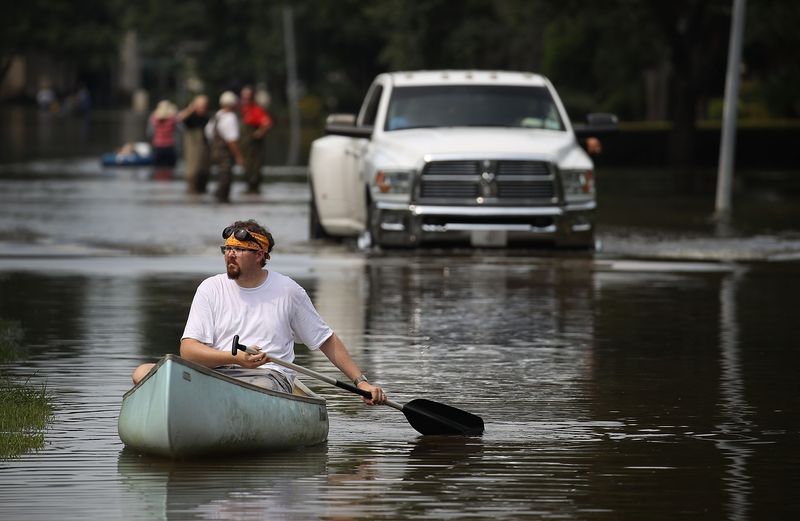In a recent talk about his new book, “Scale,” physicist Geoffrey West described climate change as a form of entropy –- disorder that’s created as the price of all the order and creative energy pent up in cities. In this view, climate change is not, as some argue, just a euphemism for global warming. It’s a broader term that reflects the unpredictable, disorderly way global warming will affect the planet’s oceans and atmosphere.
In other words, we won’t be so lucky as to see a regular, incremental increase in the earth’s average temperature. Instead, we’re seeing rapid, erratic changes in weather patterns that people have counted on for centuries.
Consider one of the more interesting hypotheses about global warming: that it will cause the wind patterns that normally keep storms moving from place to place to slow down, causing prolonged downpours as well as droughts. It’s an idea that’s been cited in the peer-reviewed literature and featured in Scientific American, but like many exciting ideas in science, it’s still not universally accepted. Some are waiting for more evidence.
For people who’ve looked into the slowing of wind circulation, however, Hurricane Harvey was a case in point. Part of the reason it was so destructive was because it got slowed down over Houston. The storm was caught between two high-pressure blocking systems shortly after it made landfall in Texas, so instead of rolling over the region, it got stuck for several days, dumping 50 inches of rain over an enormous area –- a total of 19 trillion gallons. The longer it lingered, the more rain fell; ultimately, some parts of the state saw a year’s worth of rainfall in less than a week.
Charles Greene, an atmospheric scientist at Cornell University, believes that warming in the Arctic led to a slowing down of a high-altitude, circulating wind known as the jet stream, which he argues contributed to Harvey’s lingering destruction. If that turns out to be the case, it portends more such events to come. He suspects recent droughts in the western United States may have been exacerbated by the same phenomenon, as a more sluggish jet stream allowed masses of dry air to get locked into place.
Why would global warming affect winds and storms? As Greene explains, warming isn’t happening in a uniform way. The Arctic is warming faster than the earth’s temperate zones, and so there’s less of a difference than there used to be between Arctic and mid-latitude temperatures. “These temperature differences are what drive atmospheric winds,” he said, which include the jet stream and a more northerly circulation pattern called the polar vortex. The polar vortex normally confines frigid air to the Arctic, and when it weakens, Arctic air can swing south and create unusually cold weather at lower latitudes.
The Arctic is warming faster than the rest of the planet because there’s a positive feedback loop at work. As reflective sea ice melts, it exposes dark ocean underneath, he said. That means more of the sun’s energy gets absorbed into the oceans, driving yet more warming in a positive feedback system. In the fall, some of the ocean’s heat is released back into the atmosphere. That change in Arctic temperature alters the polar vortex, slowing and weakening it. That has coincided with an increase in the number of tropical cyclones and nor’easters.
In his view, the warming Arctic is also causing the jet stream to slow, and thereby allowing the formation of more “blocks” of high pressure to lock storms such as Harvey in place. He acknowledges, however that there isn’t enough evidence yet to link cause and effect, or rule out natural variability.
Kevin Trenberth, climate scientist at the National Center for Atmospheric Research in Boulder, Colorado, says Greene and his colleagues have more work to do to demonstrate the links between Arctic melting, wind patterns and extreme weather. But there are already well-established links between global warming and storms.
Trenberth’s work focuses on the oceans, which are heating up along with the atmosphere. While the surface of the ocean has been slowly warming since the mid-20th century, the 1990s brought something new: Water started to warm up 700 to 2,000 meters below the surface. The increase is small, he said, but the total energy pent up under the surface is enormous. Normally, big storms churn up cold water from the depths, and this allows their energy to peter out. Now that there’s warmer water below the surface, there’s extra heat available, he said, and that can cause a storm to intensify and last longer.
And that’s not the only way global warming can lead to more destructive storms. It’s well understood that warmer air holds more moisture, which allows Harvey and other storms to pack more precipitation. Warmer oceans also likely added fuel to this storm, and will continue to do so over the course of the century. The water in the Gulf of Mexico is 2 to 4 degrees warmer than it has been historically this time of year, said Greene. Warmer water allows storms to intensify fast, as Harvey did by going from Category 2 to Category 4 without hours. Now, Hurricane Irma seems to be doing the same thing as it heads toward Florida.
The arguments among scientists are for the most part not about whether global warming is contributing to extreme weather, but which consequences of global warming will wreak the most havoc. In his talk, physicist Geoffrey West explained that the kind of disorder associated with global warming is the price we pay for our ordered civilization. There’s no reason to be ashamed that it’s happened — or to deny it. Better to look forward and realize it’s still possible to mitigate the damage, and to adapt.
(Bloomberg)
